
编者按
中央美术学院美术馆新馆发展十余年间,在承袭馆藏研究与中国现当代美术史展示的历史基础上,还将更多精力投入到当代思想观念的生产与更新、国际文化艺术的交流与碰撞之中。持续性的海外机构对话展览、世界名家策划展览、前沿动态专题讲座和跨区域学术研讨,展示了央美美术馆参与缔造时代文化的国际襟怀,也为公众和学界提供了更为丰富的可观对象和可言场域。在2019年由央美美术馆发起的“国际艺术博物馆联席论坛”上曾提出知识共享与数字技术正对美术馆的未来发起挑战,而应对的方式则可能在于视野的开敞与交流的反思之间。
在此,围绕发生在央美美术馆的国际展览与活动,该板块将甄选若干回溯性或研究性的文章,在梳理近年来海外拓展方面的工作之际,也尝试为读者展现美术馆的国际视野。
雷安德罗·埃利希的冒险
北川富朗
国际艺术界著名策展人
越后妻有大地艺术祭及濑户内国际艺术祭发起人
雷安德罗·埃利希是一位试图跳出画廊和美术馆等均质空间的艺术家。突破以20世纪的城市高层建筑群为象征的均质空间,无疑是一项大胆的挑战。他在当代的角色以及受欢迎的原因正根植于此。
“雷安德罗·埃利希:太虚之境”
展览作品概况
· 《建筑》:有的人倒挂在墙上,有的人紧贴墙面,也有人单手悬挂在墙上,甚至有人完全放开了双手。实际上,这是一个仰角45度的玻璃板反射的假象,人们只是躺在地上所绘制的房子上。
· 《走廊》:无限延伸的走廊是眼前真实走廊在多棱镜中的虚像。
· 《云》:那些形状看起来像法国、英国和日本列岛的云是重叠的一层层玻璃上不规则图形的集合体。
· 《电梯游说》:电梯里挤得水泄不通,但有时又只有一个很奇怪的人站在里面。
· 《教室》:隔壁的教室里,幻影般的人们正微笑着看向这边。
· 《迷失花园》:透过窗户,花园另一头房子的窗边,有个好像和我一模一样的人正在望着不同的方向。
· 《房间》:对面的公寓大楼里的每个房间都在慢慢地发生变化。
· 《人行道》:当我以为自己站在很高的地方俯视着下方的公寓楼时,却发现自己只是站在地面上而已。
· 《窗与梯》:空中仅漂浮着老旧建筑的一块墙壁。
· 《反射港湾》:几艘小船漂浮在没有水的水面上,呈现出水面的涟漪。
· 《游泳池》:从游泳池的上面可以看到各种各样的人在水下行走。
· 《试衣间》:本应是单间的试衣间全连在了一起,内部一览无余。
· 《门》:门底泄出光亮,而以为的房间实际上发现不过是墙壁。
· 《雨》:在一个天气良好的日子里,从室内向窗外望去却是一阵阵狂风暴雨。
· 《美发沙龙》:理发店里,我所面对的玻璃镜上,有个本不该有的人站在我身后。
· 《连根拔起》:走到室外,空中浮着一个被整个吊起来的房子。

《迷失花园》(Lost Garden),2009,中央美术学院美术馆展览现场
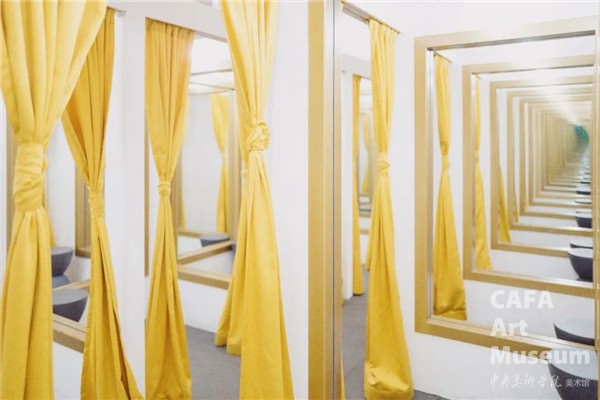
《试衣间》(Changing Rooms),2008,中央美术学院美术馆展览现场
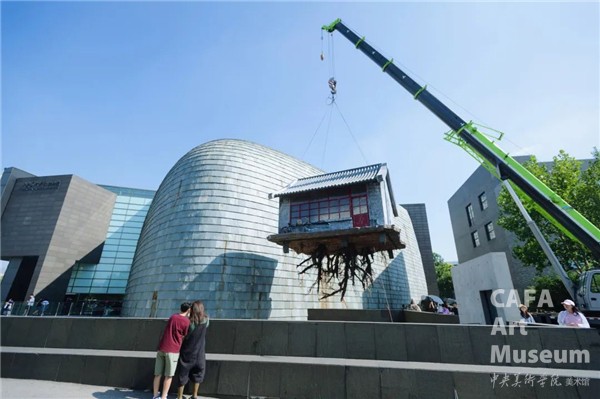
《连根拔起》(Pulled by the Roots),2015,中央美术学院美术馆展览现场
均质空间是20世纪(或者说是现代)的主导思想。密斯·凡德罗认为,资本和劳动力集中在城市,正是这种集中构筑了由钢骨和玻璃幕墙组成的高楼林立的大都市。实际上,世界各地都出现了以高层建筑群为中心的城市。无论是中国、欧美还是非洲都是如此。这种空间被抽离了生活的多层性和历史的沉淀,成为像实验室一样空虚的空间。这样的建筑物只需通过改变房间的间壁,就可以被很容易地改造成住宅、办公室或餐厅。只要调节好室内空气,就没有比这更方便的建筑了。而人在这里仅作为一个可量化的数字被统计和操纵。
空间失去了土地特有的历史与风土,人类被以计量和统计的方式所定义——这正是在全球市场经济的冲击下遍及全球的思维方式。艺术也在这样的框架下联动发展。被白色高墙包围的“白盒子”,在任何国家、地区都呈现出同样的面貌,是与周围环境割离的空间。在这种机会均等的空间里,作品可以纯粹地展示其核心之概念,可以说是科学实验室或研究室一样的地方,我们可以清楚地理解艺术家的思维之跃动。
但是,还有一个很大的问题。
这种理想的抽象的空间在现实中真的可能存在吗?
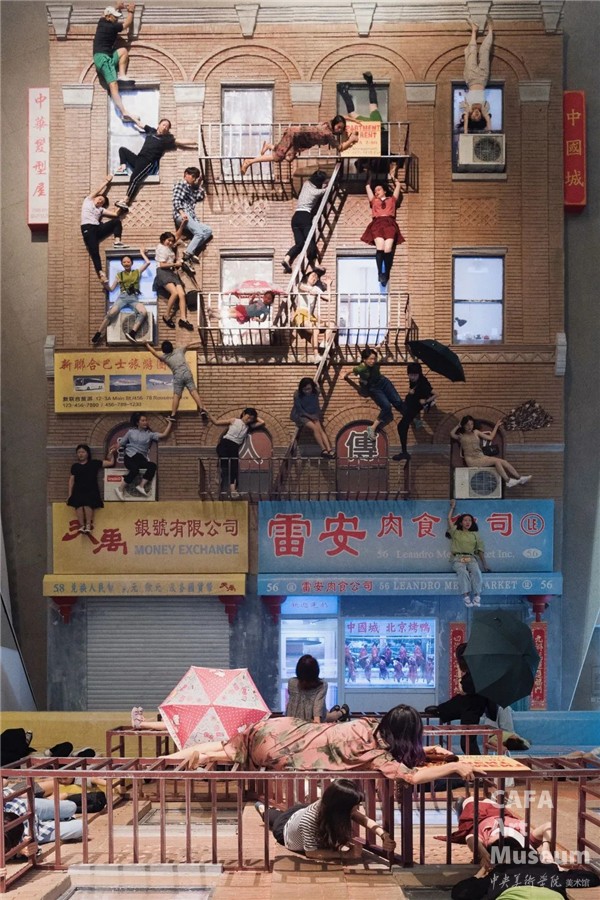
《建筑(中国城)》(Bâtiment (Chinatown)),2004,中央美术学院美术馆展览现场
我们真正面临的问题是全球环境的不断恶化,是跨国大资本家掌控下市场经济一边倒造成社会贫富差距加大,是由此带来的资本主义的道德崩坏导致每个人的感性丧失、机械化,是地域本土文化的消失。自古以来,当身处文明的危机中、时代的转折点时,艺术家都会将人与自然、人与文明的关系揭露出来。他们所使用的是一种人为的技术(artificial technique)。
阿尔塔米拉和拉斯科的洞穴壁画,既为人类拼死捕杀中型猛兽的艰辛而祈祷,也为倒下的动物所遭受的痛苦而祈祷,是存活的群体与自然之间关系的象征。此后无论在哪个时代,艺术都反映了自然、社会与人类之间的联系。在偶然形成的浩瀚无垠的宇宙里,对于诞生于其中某个瞬间的人类来说,艺术是自我认知的唯一指标。没有坐标,人类就无法生存。而艺术与语言和文学一样,都是普遍意义上的坐标(土著居民的绘画就是非常好的例子)。雷安德罗·埃利希利用透明板、玻璃和水等材料的界面差异来试着打破界限,使用从现代工业中产生的优质材料在无形的均质空间领域里设置屏障,这便是他的创作手法。
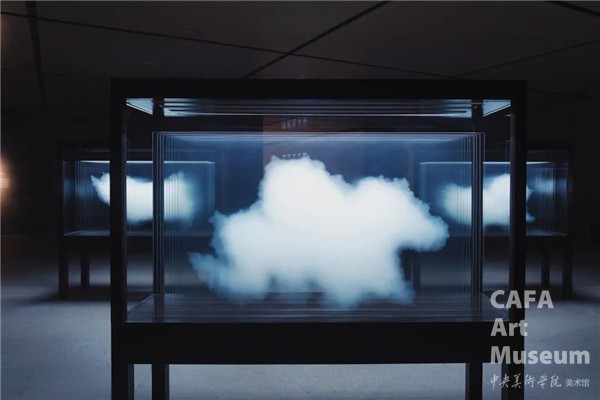
《云》(Clouds),2017,中央美术学院美术馆展览现场
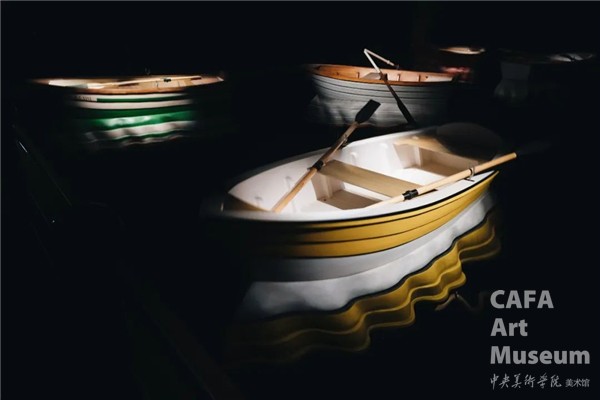
《反射港湾》(Port of Reflections),2014,中央美术学院美术馆展览现场
我们每个人都处于全球信息的终端,被各种信息、符号和传闻所淹没,并认为自己可以自由地选择和提取这些信息。然而,它们只是由庞大的权力、资本和网络所操纵所允许的信息而已。
这些信息以特定的形象固定下来,艺术也曾因此有停滞不前的时期。我们看似可以从无数信息中作出自由的选择,但对这些信息的组合与思维方式却正趋于公式化。
在这样一个时代里,雷安德罗·埃利希登场了。
一件作品无论是放在北京、约翰内斯堡,还是伦敦展出,人们都可以同样的方式来观赏和理解。这是20世纪艺术在画廊和美术馆等白盒子里展示的标准,也是20世纪思想的理念。这种均质空间与市场经济、国际金融和互联网具有相同性质,是20世纪最有影响力(最好)的思想理念,甚至可以说艺术是在这种均质空间的基础上发展的。
——无论在何处都可以用同一种观点来评价事物。
那么,为了超越这种均质空间,雷安是如何思考的呢?让我们来看看世界上古老象形文字汉字的含义吧。
yi移す(うつす)→誊写、抄送、保管、记录。
ying映す(うつす)→光线等照在其他物体上映出物体的原样。
xie写す(うつす)→模仿原样品制造。翻印、仿造原件。
这三个原本有着相同词源的词语逐渐发生变化,形成了“うつす”的现代用法。[1]
上面所列举的雷安德罗·埃利希的这些作品,用日语来说,或者用汉字来写,不都像是将“utsusu”[2]这种人类行为所表示的情境,在一个瞬间且唯一的场所里表现出来吗?
他在这里将空间的时间封印起来,有如封闭在电影里的时间。在他看来,均质空间由于缺少时间的积累而异常冷漠。因此,他的办法是通过转移一个均质空间来从均质空间的内部突破其自身。
现在的空间不过是一种不具备时间概念的东西。雷安德罗·埃利希在这里提出通过“移、写、映”的主体变化来思考空间,其中客体随着人类(主体)的行为发生变化。这也是自古以来人类与自然的关系。我尝试在中国的汉字中寻找发音相同,且蕴含着转变契机之意的词汇来探索这种关系。这就是恩斯特·马赫所讲述的“共同主观”,也是自古以来共观福音书[3]里所描述的世界。简单来说,正因为我对“站”这个词语的含义产生了共感,镜子里映出的我的形象才是站立着的。
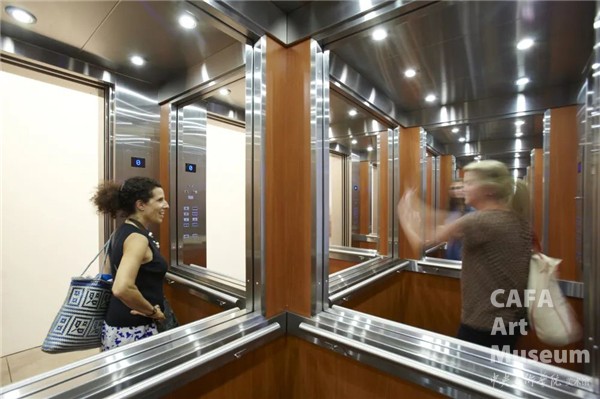
《电梯迷宫》(Elevator Maze), 2011,美国纽约肖恩·凯利画廊展览现场
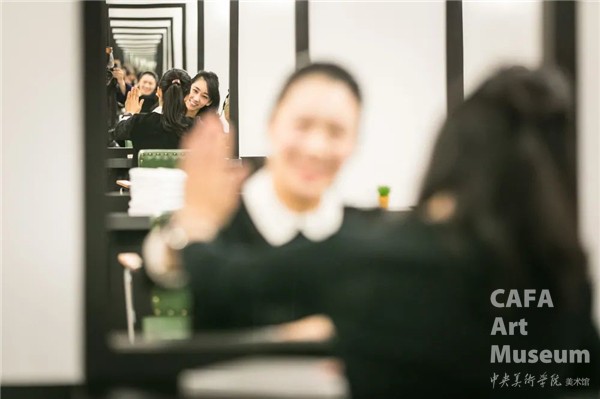
《美发沙龙》(Hair Salon),2017,日本东京森美术馆展出现场
我在这里想先谈一下雷安德罗·埃利希创作手法中的确定性。正值这次他的展览在中国举办,我想根据活跃于5世纪末至6世纪的中国画家兼评论家谢赫所著的《古画品录》序言中的“绘画六法”来说明。这一时代正好是佛教作为来自印度的思想体系传入中国的时期,也是“艺术”本身被质疑如何能够理解并反映人类所感知的自然和社会的一段时期。至少在亚洲文化的最终传播地的日本,“绘画六法”长久以来被视为重要的艺术理论。
这种绘画表现的基本元素也作为一种通用基准,被出色地应用于现代美术的作品创作中。
应物象形:造型能力
随类赋彩:色彩感知
经营位置:空间构成
这些元素是建筑家出身的雷安德罗·埃利希最擅长的领域,也是令他的作品明快易懂的原因。
传移模写:掌握经典或前人的成就
这种创作实践可以确保作品的现代性。换句话说,它是为观众提供新的空间体验的基础,从中可以看出雷安德罗·埃利希渊博的知识。
骨法用笔:艺术家独特的手法和感觉
基于上述,我在前面谈到过雷安德罗·埃利希的个人艺术理念,也就是说,他是通过“移、写、映”的方式在均质的空间里创造出一个虚无的空间,进而创作出一个新的丰富的空间。
六法中,以上五项都可以通过修习获得,而剩下的“气韵生动”则并非如此。
气韵生动应该说是作品和观众之间产生的感应。换句话说,指的是一种新的空间体验的实现。谢赫认为,作品之品的高低,取决于其是否能够引起使观者震撼,是否有着仿若地动山摇的力量。雷安德罗·埃利希的作品似乎已踏出了追求气韵生动的一步。
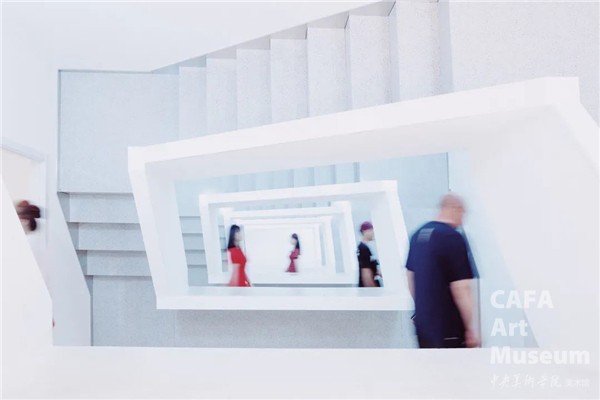
《楼梯(CAFAM)》(Staircase (CAFAM)),2005,中央美术学院美术馆展览现场
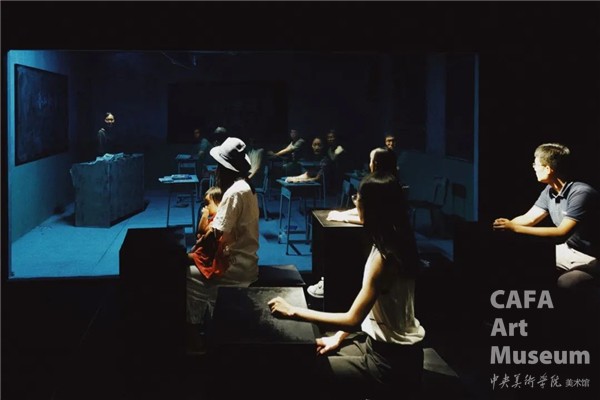
《教室》(Classroom),2017,中央美术学院美术馆展览现场
雷安德罗·埃利希在其故乡布宜诺斯艾利斯创作了一件叫作《象征的民主》的公共作品。这件作品将这个城市象征性的方尖碑的顶部遮盖起来,然后把其顶部的复制品放置在美术馆展示。这里的作品看似在“转移”之前被“隐藏”,实际上却是被隐藏之后另外制作出来的。我虽然没有去过,但听说那里既是情侣约会见面,也是进行抗议活动集会的热门地点。社会、政治和权力在此地共存。自古希腊时代以来,广场就是人们发表意见的地方,有时也会成为镇压的场所。而这里的象征指的是什么呢?雷安德罗·埃利希身处南美洲,却透视着整个现代,让人联想起克里斯托的艺术作品《包裹德国柏林国会大厦》,或爱森斯坦执导的电影《战舰波将金号》。均质的城市也是由权力的基础支撑起来的。那么对于现代人来说,美术馆可以作为一个足够自由的场所吗?对此我们可以保留疑问。
另外,在日本的乡村越后妻有,一座由原广司设计的令人联想到沙漠绿洲的交流馆里,雷安德罗·埃利希在它的浅水池里透写出类似城市建筑结构的建筑物,仿佛也是在通过对不断延伸扩展的现代均质空间进行转移、复制和反映来批判现代文明。人们可以从阳台上看到投影在水面上的建筑物,也可以进入水池里玩耍。埃利希开始将创作场所搬到广场和郊外,从而离正遭受着苦痛的大自然又近了一步。
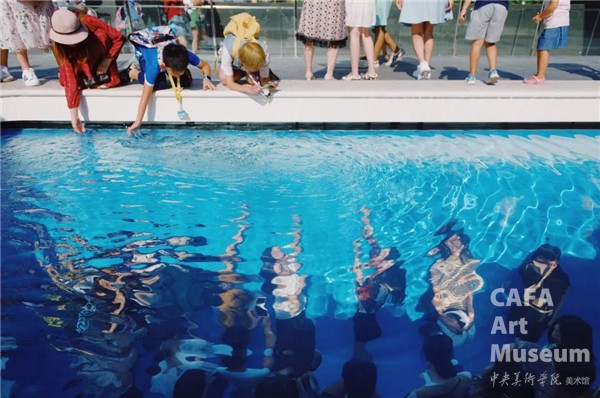
《游泳池》(Swimming Pool),2004,中央美术学院美术馆展览现场
20世纪充斥着符号化的信息、程式化的人类和千篇一律的空间,而雷安德罗·埃利希开启了一场大胆的冒险,试图借助艺术的力量来突破其中作为主导价值观的均质空间。他就像是渴望穿越到中世纪的的堂吉诃德,是一名现代的勇士。雷安德罗·埃利希出生在旧时的中南美地区,他试图以艺术创造一个如加西亚·马尔克斯以文学颠覆了欧美价值观一般的世界,从美术馆的白色立方体到象征市民社会的广场,他努力将足迹延伸到正逐渐荒废化、形式化的城市里。这样的冒险实在令人目不转睛。
注释
[1] 移、映和写的日语词汇有着相同的日语假名和读音。
[2] 此为日语“うつす”的罗马字写法。
[3] 共观福音书指基督教经典中写作方式与内容都十分相似的《马克福音》《马太福音》和《路加福音》。
CAFA Art Museum Publication Authorization Agreement
I fully agree to CAFA Art Museum (CAFAM) submitting to CAFA for publication the images, pictures, texts, writings, and event products (such as works created during participation in workshops) related to me from my participation in public events (including museum member events) organized by the CAFA Art Museum Public Education Department. CAFA can publish these materials by electronic, web, or other digital means, and I hereby agree to be included in the China Knowledge Resource Bank, the CAFA Database, the CAFA Art Museum Database, and related data, documentation, and filing institutions and platforms. Regarding their use in CAFA and dissemination on the internet, I agree to make use of these rights according to the stated Rules.
CAFA Art Museum Event Safety Disclaimer
Article I
This event was organized on the principles of fairness, impartiality, and voluntary participation and withdrawal. Participants undertake all risk and liability for themselves. All events have risks, and participants must be aware of the risks related to their chosen event.
Article II
Event participants must abide by the laws and regulations of the People’s Republic of China, as well as moral and ethical norms. All participants must demonstrate good character, respect for others, friendship, and a willingness to help others.
Article III
Event participants should be adults (people 18 years or older with full civil legal capacity). Underage persons must be accompanied by an adult.
Article IV
Event participants undertake all liability for their personal safety during the event, and event participants are encouraged to purchase personal safety insurance. Should an accident occur during an event, persons not involved in the accident and the museum do not undertake any liability for the accident, but both have the obligation to provide assistance. Event participants should actively organize and implement rescue efforts, but do not undertake any legal or economic liability for the accident itself. The museum does not undertake civil or joint liability for the personal safety of event participants.
Article V
During the event, event participants should respect the order of the museum event and ensure the safety of the museum site, the artworks in displays, exhibitions, and collections, and the derived products. If an event causes any degree of loss or damage to the museum site, space, artworks, or derived products due to an individual, persons not involved in the accident and the museum do not undertake any liability for losses. The event participant must negotiate and provide compensation according to the relevant legal statutes and museum rules. The museum may sue for legal and financial liability.
Article VI
Event participants will participate in the event under the guidance of museum staff and event leaders or instructors and must correctly use the painting tools, materials, equipment, and/or facilities provided for the event. If a participant causes injury or harm to him/herself or others while using the painting tools, materials, equipment, and/or facilities, or causes the damage or destruction of the tools, materials, equipment, and/or facilities, the event participant must undertake all related liability and provide compensation for the financial losses. Persons not involved in the accident and the museum do not undertake any liability for personal accidents.
CAFA Art Museum Portraiture Rights Licensing Agreement
According to The Advertising Law of the People’s Republic of China, The General Principles of the Civil Law of the People’s Republic of China, and The Provisional Opinions of the Supreme People’s Court on Some Issues Related to the Full Implementation of the General Principles of the Civil Law of the People’s Republic of China, and upon friendly negotiation, Party A and Party B have arrived at the following agreement regarding the use of works bearing Party A’s image in order to clarify the rights and obligations of the portrait licenser (Party A) and the user (Party B):
I. General Provisions
(1) Party A is the portraiture rights holder in this agreement. Party A voluntarily licenses its portraiture rights to Party B for the purposes stipulated in this agreement and permitted by law.
(2) Party B (CAFA Art Museum) is a specialized, international modern art museum. CAFA Art Museum keeps pace with the times, and works to create an open, free, and academic space and atmosphere for positive interaction with groups, corporations, institutions, artists, and visitors. With CAFA’s academic research as a foundation, the museum plans multi-disciplinary exhibitions, conferences, and public education events with participants from around the world, providing a platform for exchange, learning, and exhibition for CAFA’s students and instructors, artists from around the world, and the general public. As a public institution, the primary purposes of CAFA Art Museum’s public education events are academic and beneficial to society.
(3) Party B will photograph all CAFA Public Education Department events for Party A.
II. Content, Forms of Use, and Geographical Scope of Use
(1) Content. The content of images taken by Party B bearing Party A’s likeness include: ① CAFA Art Museum ② CAFA campus ③ All events planned or executed by the CAFAM Public Education Department.
(2) Forms of Use. For use in CAFA’s publications, products with CDs, and promotional materials.
(3) Geographical Scope of Use
The applicable geographic scope is global.
The media in which the portraiture may be used encompasses any media that does not infringe upon Party A’s portraiture rights (e.g., magazines and the internet).
III. Term of Portraiture Rights Use
Use in perpetuity.
IV. Licensing Fees
The fees for images bearing Party A’s likeness will be undertaken by Party B.
After completion, Party B does not need to pay any fees to Party A for images bearing Party A’s likeness.
Additional Terms
(1) All matters not discussed in this agreement shall be resolved through friendly negotiation between both parties. Both parties may then sign a supplementary agreement, provided it does not violate any laws or regulations.
(2) This agreement comes into effect on the date that it is signed (sealed) and the relevant boxes are selected by Party A and Party B.
(3) This agreement exists in paper and electronic forms. The paper form is made in duplicate, with Party A and Party B each retaining one copy with the same legal efficacy.
Event participants implicitly accept and undertake all the obligations stated in this agreement. Those who do not consent will be seen as abandoning the right to participate in this event. Before participating in this event, please speak to your family members to obtain their consent and inform them of this disclaimer. After participants sign/check the required box, participants and their families will be seen as having read and agreed to these terms.
I have carefully read and agree to the above provisions.
CAFA Art Museum Publication Authorization Agreement
I fully agree to CAFA Art Museum (CAFAM) submitting to CAFA for publication the images, pictures, texts, writings, and event products (such as works created during participation in workshops) related to me from my participation in public events (including museum member events) organized by the CAFA Art Museum Public Education Department. CAFA can publish these materials by electronic, web, or other digital means, and I hereby agree to be included in the China Knowledge Resource Bank, the CAFA Database, the CAFA Art Museum Database, and related data, documentation, and filing institutions and platforms. Regarding their use in CAFA and dissemination on the internet, I agree to make use of these rights according to the stated Rules.
CAFA Art Museum Event Safety Disclaimer
Article I
This event was organized on the principles of fairness, impartiality, and voluntary participation and withdrawal. Participants undertake all risk and liability for themselves. All events have risks, and participants must be aware of the risks related to their chosen event.
Article II
Event participants must abide by the laws and regulations of the People’s Republic of China, as well as moral and ethical norms. All participants must demonstrate good character, respect for others, friendship, and a willingness to help others.
Article III
Event participants should be adults (people 18 years or older with full civil legal capacity). Underage persons must be accompanied by an adult.
Article IV
Event participants undertake all liability for their personal safety during the event, and event participants are encouraged to purchase personal safety insurance. Should an accident occur during an event, persons not involved in the accident and the museum do not undertake any liability for the accident, but both have the obligation to provide assistance. Event participants should actively organize and implement rescue efforts, but do not undertake any legal or economic liability for the accident itself. The museum does not undertake civil or joint liability for the personal safety of event participants.
Article V
During the event, event participants should respect the order of the museum event and ensure the safety of the museum site, the artworks in displays, exhibitions, and collections, and the derived products. If an event causes any degree of loss or damage to the museum site, space, artworks, or derived products due to an individual, persons not involved in the accident and the museum do not undertake any liability for losses. The event participant must negotiate and provide compensation according to the relevant legal statutes and museum rules. The museum may sue for legal and financial liability.
Article VI
Event participants will participate in the event under the guidance of museum staff and event leaders or instructors and must correctly use the painting tools, materials, equipment, and/or facilities provided for the event. If a participant causes injury or harm to him/herself or others while using the painting tools, materials, equipment, and/or facilities, or causes the damage or destruction of the tools, materials, equipment, and/or facilities, the event participant must undertake all related liability and provide compensation for the financial losses. Persons not involved in the accident and the museum do not undertake any liability for personal accidents.
CAFA Art Museum Portraiture Rights Licensing Agreement
According to The Advertising Law of the People’s Republic of China, The General Principles of the Civil Law of the People’s Republic of China, and The Provisional Opinions of the Supreme People’s Court on Some Issues Related to the Full Implementation of the General Principles of the Civil Law of the People’s Republic of China, and upon friendly negotiation, Party A and Party B have arrived at the following agreement regarding the use of works bearing Party A’s image in order to clarify the rights and obligations of the portrait licenser (Party A) and the user (Party B):
I. General Provisions
(1) Party A is the portraiture rights holder in this agreement. Party A voluntarily licenses its portraiture rights to Party B for the purposes stipulated in this agreement and permitted by law.
(2) Party B (CAFA Art Museum) is a specialized, international modern art museum. CAFA Art Museum keeps pace with the times, and works to create an open, free, and academic space and atmosphere for positive interaction with groups, corporations, institutions, artists, and visitors. With CAFA’s academic research as a foundation, the museum plans multi-disciplinary exhibitions, conferences, and public education events with participants from around the world, providing a platform for exchange, learning, and exhibition for CAFA’s students and instructors, artists from around the world, and the general public. As a public institution, the primary purposes of CAFA Art Museum’s public education events are academic and beneficial to society.
(3) Party B will photograph all CAFA Public Education Department events for Party A.
II. Content, Forms of Use, and Geographical Scope of Use
(1) Content. The content of images taken by Party B bearing Party A’s likeness include: ① CAFA Art Museum ② CAFA campus ③ All events planned or executed by the CAFAM Public Education Department.
(2) Forms of Use. For use in CAFA’s publications, products with CDs, and promotional materials.
(3) Geographical Scope of Use
The applicable geographic scope is global.
The media in which the portraiture may be used encompasses any media that does not infringe upon Party A’s portraiture rights (e.g., magazines and the internet).
III. Term of Portraiture Rights Use
Use in perpetuity.
IV. Licensing Fees
The fees for images bearing Party A’s likeness will be undertaken by Party B.
After completion, Party B does not need to pay any fees to Party A for images bearing Party A’s likeness.
Additional Terms
(1) All matters not discussed in this agreement shall be resolved through friendly negotiation between both parties. Both parties may then sign a supplementary agreement, provided it does not violate any laws or regulations.
(2) This agreement comes into effect on the date that it is signed (sealed) and the relevant boxes are selected by Party A and Party B.
(3) This agreement exists in paper and electronic forms. The paper form is made in duplicate, with Party A and Party B each retaining one copy with the same legal efficacy.
Event participants implicitly accept and undertake all the obligations stated in this agreement. Those who do not consent will be seen as abandoning the right to participate in this event. Before participating in this event, please speak to your family members to obtain their consent and inform them of this disclaimer. After participants sign/check the required box, participants and their families will be seen as having read and agreed to these terms.
I have carefully read and agree to the above provisions.
CAFA Art Museum Publication Authorization Agreement
I fully agree to CAFA Art Museum (CAFAM) submitting to CAFA for publication the images, pictures, texts, writings, and event products (such as works created during participation in workshops) related to me from my participation in public events (including museum member events) organized by the CAFA Art Museum Public Education Department. CAFA can publish these materials by electronic, web, or other digital means, and I hereby agree to be included in the China Knowledge Resource Bank, the CAFA Database, the CAFA Art Museum Database, and related data, documentation, and filing institutions and platforms. Regarding their use in CAFA and dissemination on the internet, I agree to make use of these rights according to the stated Rules.
CAFA Art Museum Event Safety Disclaimer
Article I
This event was organized on the principles of fairness, impartiality, and voluntary participation and withdrawal. Participants undertake all risk and liability for themselves. All events have risks, and participants must be aware of the risks related to their chosen event.
Article II
Event participants must abide by the laws and regulations of the People’s Republic of China, as well as moral and ethical norms. All participants must demonstrate good character, respect for others, friendship, and a willingness to help others.
Article III
Event participants should be adults (people 18 years or older with full civil legal capacity). Underage persons must be accompanied by an adult.
Article IV
Event participants undertake all liability for their personal safety during the event, and event participants are encouraged to purchase personal safety insurance. Should an accident occur during an event, persons not involved in the accident and the museum do not undertake any liability for the accident, but both have the obligation to provide assistance. Event participants should actively organize and implement rescue efforts, but do not undertake any legal or economic liability for the accident itself. The museum does not undertake civil or joint liability for the personal safety of event participants.
Article V
During the event, event participants should respect the order of the museum event and ensure the safety of the museum site, the artworks in displays, exhibitions, and collections, and the derived products. If an event causes any degree of loss or damage to the museum site, space, artworks, or derived products due to an individual, persons not involved in the accident and the museum do not undertake any liability for losses. The event participant must negotiate and provide compensation according to the relevant legal statutes and museum rules. The museum may sue for legal and financial liability.
Article VI
Event participants will participate in the event under the guidance of museum staff and event leaders or instructors and must correctly use the painting tools, materials, equipment, and/or facilities provided for the event. If a participant causes injury or harm to him/herself or others while using the painting tools, materials, equipment, and/or facilities, or causes the damage or destruction of the tools, materials, equipment, and/or facilities, the event participant must undertake all related liability and provide compensation for the financial losses. Persons not involved in the accident and the museum do not undertake any liability for personal accidents.
CAFA Art Museum Portraiture Rights Licensing Agreement
According to The Advertising Law of the People’s Republic of China, The General Principles of the Civil Law of the People’s Republic of China, and The Provisional Opinions of the Supreme People’s Court on Some Issues Related to the Full Implementation of the General Principles of the Civil Law of the People’s Republic of China, and upon friendly negotiation, Party A and Party B have arrived at the following agreement regarding the use of works bearing Party A’s image in order to clarify the rights and obligations of the portrait licenser (Party A) and the user (Party B):
I. General Provisions
(1) Party A is the portraiture rights holder in this agreement. Party A voluntarily licenses its portraiture rights to Party B for the purposes stipulated in this agreement and permitted by law.
(2) Party B (CAFA Art Museum) is a specialized, international modern art museum. CAFA Art Museum keeps pace with the times, and works to create an open, free, and academic space and atmosphere for positive interaction with groups, corporations, institutions, artists, and visitors. With CAFA’s academic research as a foundation, the museum plans multi-disciplinary exhibitions, conferences, and public education events with participants from around the world, providing a platform for exchange, learning, and exhibition for CAFA’s students and instructors, artists from around the world, and the general public. As a public institution, the primary purposes of CAFA Art Museum’s public education events are academic and beneficial to society.
(3) Party B will photograph all CAFA Public Education Department events for Party A.
II. Content, Forms of Use, and Geographical Scope of Use
(1) Content. The content of images taken by Party B bearing Party A’s likeness include: ① CAFA Art Museum ② CAFA campus ③ All events planned or executed by the CAFAM Public Education Department.
(2) Forms of Use. For use in CAFA’s publications, products with CDs, and promotional materials.
(3) Geographical Scope of Use
The applicable geographic scope is global.
The media in which the portraiture may be used encompasses any media that does not infringe upon Party A’s portraiture rights (e.g., magazines and the internet).
III. Term of Portraiture Rights Use
Use in perpetuity.
IV. Licensing Fees
The fees for images bearing Party A’s likeness will be undertaken by Party B.
After completion, Party B does not need to pay any fees to Party A for images bearing Party A’s likeness.
Additional Terms
(1) All matters not discussed in this agreement shall be resolved through friendly negotiation between both parties. Both parties may then sign a supplementary agreement, provided it does not violate any laws or regulations.
(2) This agreement comes into effect on the date that it is signed (sealed) and the relevant boxes are selected by Party A and Party B.
(3) This agreement exists in paper and electronic forms. The paper form is made in duplicate, with Party A and Party B each retaining one copy with the same legal efficacy.
Event participants implicitly accept and undertake all the obligations stated in this agreement. Those who do not consent will be seen as abandoning the right to participate in this event. Before participating in this event, please speak to your family members to obtain their consent and inform them of this disclaimer. After participants sign/check the required box, participants and their families will be seen as having read and agreed to these terms.
I have carefully read and agree to the above provisions.

